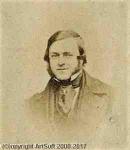John Middleton
John Middleton
Place: Norwich
Born: 1827
Death: 1828
Biography:
John Middleton was an English artist, known for his accomplished work as a painter of watercolours. He was the youngest and the last important member of the Norwich School of painters, and, cut short by his death at the age of 29, he had one of the shortest careers.
His father (also called John) was a Norwich glass stainer, and his mother painted plants and occasionally exhibited her work with the Norwich Society of Artists. Middleton was educated in Norwich and studied art under John Berney Crome and Henry Bright. He was the devoted young companion and a pupil of Thomas Lound. Middleton's paintings were exhibited before he was twenty, and he went on to exhibit at both the Royal Academy and the British Institution. Many of his works have been acclaimed by art historians for their purity, confidence and freshness, which gives them a more modern appearance than the sometimes over-detailed works of other Victorian painters. Middleton was a member of Norwich's early amateur photographic community, using waxed paper negatives to depict the Norfolk countryside. He worked as an etcher, notably producing Nine Etchings by John Middleton, c.1852.
His early death from tuberculosis in 1856 has been described by the art historian Josephine Walpole as "the supreme tragedy for the Norwich School of painters".
John Middleton was born on 9 January 1827 in Norwich in the English county of Norfolk. Parish records show that he was baptised on 14 January at St Stephen's Church, Norwich, by his parents John and Ann Middleton. Little of his early childhood has been documented, and his biographers do not mention any siblings. His father John was a glass stainer, who was the business successor of Daniel Coppin, one of the founding members of the Norwich Society of Artists. Coppin's daughter Emily and her husband Joseph Stannard were themselves artists associated with the Norwich School. In addition to running a glass colouring business, John Middleton senior undertook plumbing and painting work and studied and collected ferns in his spare time. His wife Ann specialised in painting plants, exhibiting with the Norwich Society under the name of 'Mrs. J. Middleton' in 1828 and 1829.
Middleton was educated at Norwich Grammar School. He went on to study under John Berney Crome, one of the artistic sons of John Crome, and with Henry Bright, whom he visited in London in 1847. He moved from Norwich to London at this time and lived at 1, The Terrace, Kensington. From 1847 to 1849 he worked as Henry Bright's pupil and friend, travelling with him on a trip to Kent. He became the devoted young companion of Thomas Lound, who taught him to paint in watercolours and who later bought many of his paintings.
In 1849, a year after the death of his father, Middleton moved back from London to St. Stephen's Street in Norwich, to care for his widowed mother and to take over the running of the family business. His duties both interrupted his training and acted to reduce his artistic output. In 1850 he moved with his mother to Surrey Street.
Middleton was a precocious artist, exhibiting before he was twenty. He exhibited in London from 1847 to 1855, despite the interruption caused by his business commitments: he showed fourteen pictures at the Royal Academy and fifteen at the British Institution, where his work was acclaimed.
Bright so influenced Middleton that it often difficult to distinguish between the two artists. He was also influenced by John Berney Ladbrooke, a significant Norwich School artist who produced a large output of works, despite having to earn a living as a drawing teacher. He travelled to various parts of Britain during his working life. During excursions to Tunbridge Wells in Kent, and the Devon coast, he spent time sketching and painting. Included amongst the works he exhibited in London were Clovelly, on the coast of Devonshire (1851) and Scene near Tunbridge Wells (1847).
During much of his life Middleton suffered from poor health. He became consumptive and became gradually less capable of working outdoors as his illness steadily advanced. Clifford notes that Middleton's inspiration, brilliant colours and confidence in his drawings tailed away after 1848, four years before his last known drawing was made.
He died of tuberculosis at his home in Surrey Street on 11 November 1856, aged only 29. He was buried in the new cemetery at Earlham, opened in 1856 following a ruling from the Government that burials in Norwich's churchyards could no longer be permitted. When his death was announced in the local Norfolk press, it was noted that he "painted nature just as he found her in the quiet sequestered nooks which abound in this county, and many a spot, otherwise of little note, will live long on the canvas touched by Middleton’s hand". The author Josephine Walpole has described his death as "the supreme tragedy for the Norwich School", comparing his talents as a water colourist as being equal to, or better than, those of John Sell Cotman and John Thirtle, and dismissing the idea that prior to his death his works had lost their earlier 'fire and life' because the artist peaked at too early an age.
More...














